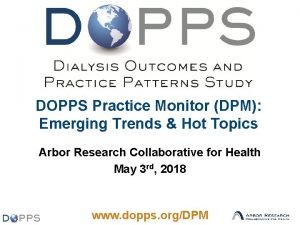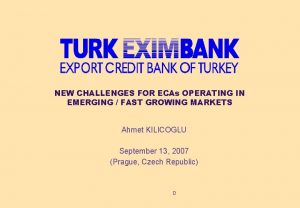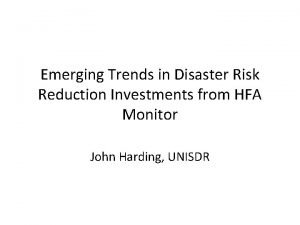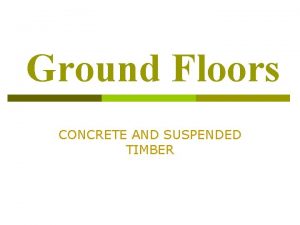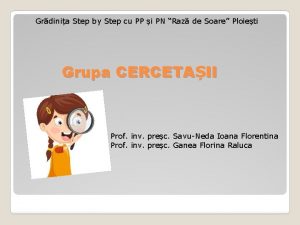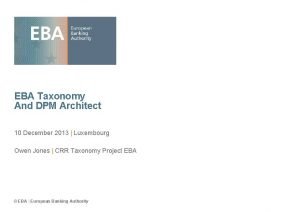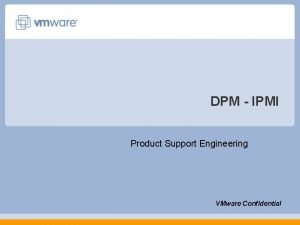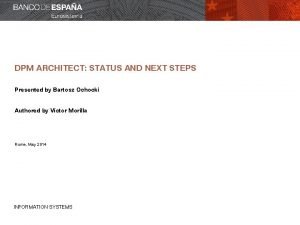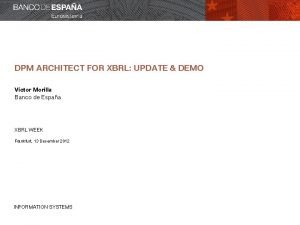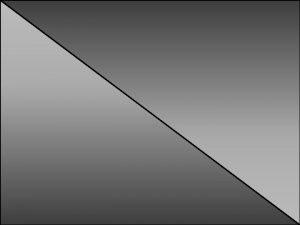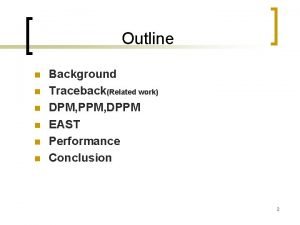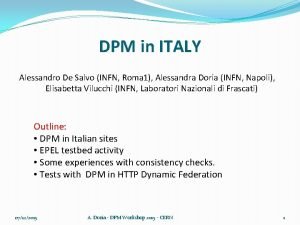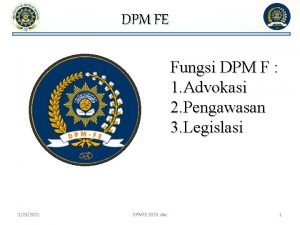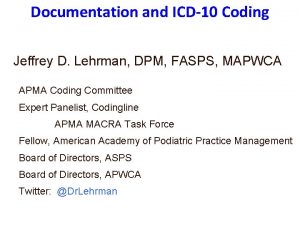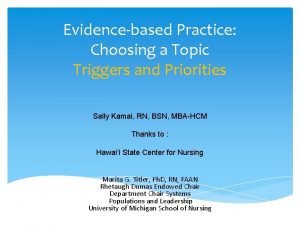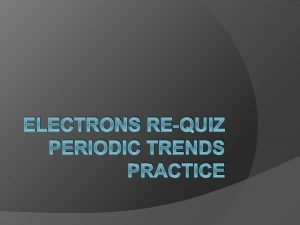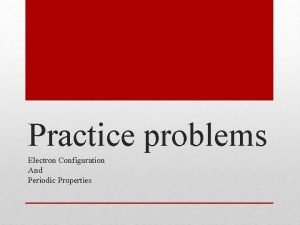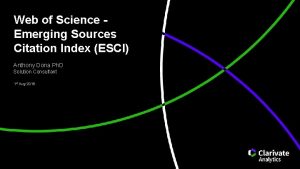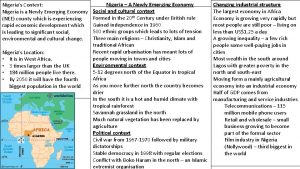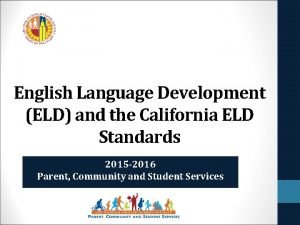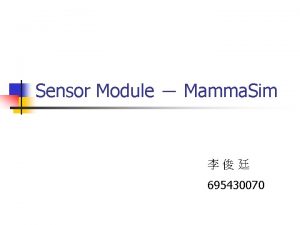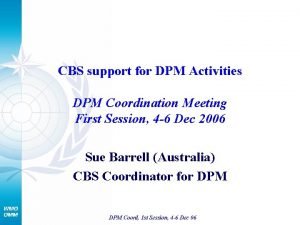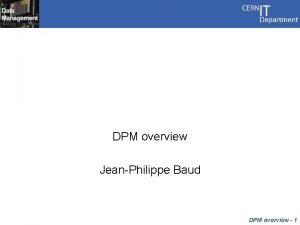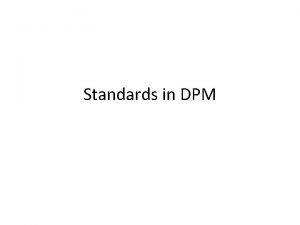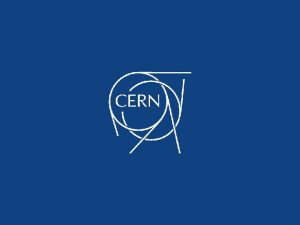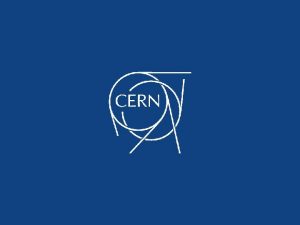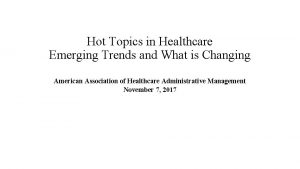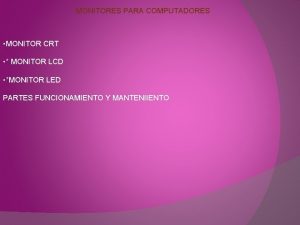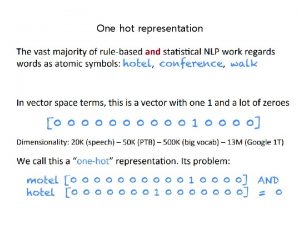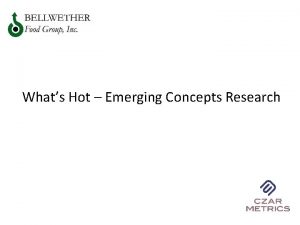DOPPS Practice Monitor DPM Emerging Trends Hot Topics




































































- Slides: 68

DOPPS Practice Monitor (DPM): Emerging Trends & Hot Topics Arbor Research Collaborative for Health May 3 rd, 2018 www. dopps. org/DPM

Topics and Speakers Today • Welcome and Introduction (5 min) Bruce Robinson • Recent US Trends (15 min) Doug Fuller • Focus topic: Pruritus (20 min) Hugh Rayner • Vascular Access (20 min) Ron Pisoni Bruce Robinson Doug Fuller Hugh Rayner Ron Pisoni

Acknowledgements, 2018 The DOPPS Program would not be possible without the support for independent scientific research to improve patient care from the following organizations: Principal Funders: Amgen Baxter Healthcare Kyowa Hakko Kirin Country/Project-Specific Support: ERA-EDTA, Vifor Fresenius Renal Pharma, Keryx, Amgen, Astra. Zeneca, Relypsa, Roche, Proteon, Janssen, Hexal, Japanese Society for PD, Societies of Nephrology in Germany, Italy & Spain Public Funding of Projects/Ancillary Studies In: Australia, Canada, France, Thailand, United Kingdom, United States All support for the DOPPS program is provided without restrictions on publications

New AHRQ* grant: To study prevention of peritonitis in PD patients, & to promote knowledge dissemination strategies • Investigators: Drs. Jeff Perl and Ron Pisoni (Co-PIs), Neil Boudville, Beth Piraino, Doug Schaubel, Martin Schreiber, Isaac. Teitelbaum. • Stakeholders: - International Society for Peritoneal Dialysis (ISPD) - ASN (Nephrologists Transforming Dialysis Safety, NTDS) - CDC NHSN members - International Pediatric PD Network (IPPN) - Standardizing Care to Improve Outcomes in Pediatric End Stage Renal Disease (SCOPE) collaborative - US dialysis providers - Patient representatives *AHRQ = Agency for Healthcare Research and Quality (US DHHS)

Join the conversation on Twitter • Follow us @DOPPStudy • Use #DOPPS for tweets about today’s presentation

Submitting Questions We welcome your questions throughout the session and will pause to answer them at the end of each section Please submit your questions using the “Chat with Presenter” feature, accessed by the blue icon located at the bottom left corner of the screen

Interactive Polling • Throughout today’s presentation, we will offer several poll questions about treatment practices in your unit. Please be assured that individual responses will remain confidential. • When the poll is opened and displays on your screen, please answer the question and don’t forget to hit the ‘Submit’ button.

US DOPPS Practice Monitor: Highlights May 2018 Doug Fuller, MS Arbor Research Collaborative for Health

US DPM: Monthly data, updates every 4 months; >1500 figures & tables Stratified random sample (since 2010) Now ~200 US facilities, 14, 000+ patients with data from 2 LDOs and Visonex www. dopps. org/DPM

Uptake of Newer Medications

Iron-containing Phosphate Binder Use – Prior 3 Months – National sample 40 35 30 Percent 25 20 15 10 5 2. 4 2. 8 2. 7 3. 3 3. 5 4. 1 5. 1 4. 8 5. 4 5. 7 5. 9 5. 8 6. 4 7. 0 7. 1 0 JUN 152881 OCT 153053 FEB 163085 JUN 163117 OCT 162958 FEB 172865 JUN 172863 OCT 172919 FEB 182909 N Pts: Values for each month reflect any prescription during prior 3 months. Source: US-DOPPS Practice Monitor, April 2018; http: //www. dopps. org/DPM

ESA Use, by Type – by Dialysis Organization (DO) Size – Epoetin 100 3 Darbepoetin Large/medium DO (10+ units) Pegylated epoetin beta Small DO (<10 units) and independents 5 9 20 30 80 12 37 37 40 43 46 44 27 42 50 Percent 4 4 60 6 97 40 8 8 86 69 67 0 FEB 153760 78 90 88 91 91 92 14 14 73 60 58 20 N Pts: 69 FEB 163698 53 49 FEB 173951 58 41 42 FEB 183985 FEB 154670 50 31 22 FEB 164058 Values for each month reflect prescription among ESA-treated patients. Source: DOPPS Practice Monitor, April 2018 10 12 9 FEB 173805 9 8 FEB 182801

Anemia

Hemoglobin Trends – National Sample – National sample 13 12. 2 12. 1 12. 3 12. 1 12. 2 12. 4 12. 3 12. 1 12 g/d. L 10. 8 10. 7 10. 8 10. 7 11 10 9. 4 9. 3 9. 2 9. 3 9. 4 9. 1 9. 2 9 FEB 15 N Pts: 8320 JUN 15 6176 OCT 15 8199 FEB 16 8260 JUN 16 8057 OCT 16 7595 FEB 17 7684 JUN 17 7487 OCT 17 4907 FEB 18 6745 Most recent (single) monthly value; vertical lines extend from 10 th to 25 th (lower) and 75 th to 90 th (upper) percentiles; circle represents median. Source: US-DOPPS Practice Monitor, April 2018; http: //www. dopps. org/DPM

Prescription of Anemia Therapies (% patients) – Prior 3 Months – National sample 100 90 87 80 81 Percent 81 91 82 91 90 91 91 84 84 84 85 86 85 91 91 90 87 87 86 90 90 89 88 84 82 81 80 80 8 7 ESA IV Iron SQ ESA (non-LDO) SQ ESA (LDO) 60 40 90 37 28 31 31 27 29 26 27 21 20 18 13 11 10 9 8 0 FEB 15 JUN 15 OCT 15 FEB 16 JUN 16 OCT 16 FEB 17 Values for each month reflect any use during the prior three months. Source: US-DOPPS Practice Monitor, April 2018; http: //www. dopps. org/DPM JUN 17 OCT 17 FEB 18

Serum Ferritin – National Sample – National sample 1, 800 1, 600 1, 461 1, 438 1, 392 1, 413 814 809 779 276 287 302 275 FEB 17 8438 JUN 17 8267 OCT 17 5299 FEB 18 7535 1, 366 1, 392 750 768 755 767 763 788 277 267 290 279 273 266 FEB 15 JUN 15 6875 OCT 15 8972 FEB 16 8831 JUN 16 9133 OCT 16 8200 1, 400 1, 373 1, 341 1, 299 1, 361 ng/m. L 1, 200 1, 000 793 800 600 400 200 0 N Pts: 8929 Values at each month are based on the most recent measurement obtained within the prior 3 months; vertical lines extend from 10 th to 25 th (lower) and 75 th to 90 th (upper) percentiles; circle represents median. Source: US-DOPPS Practice Monitor, April 2018; http: //www. dopps. org/DPM

Mineral and Bone Disorder

Parathyroid Hormone (PTH) – National Sample – National sample 1, 200 1009 946 929 913 904 922 894 871 874 1, 000 885 873 851 949 1009 982 983 1002 820 pg/m. L 800 600 400 382 379 380 364 356 367 365 368 366 370 373 356 338 332 335 343 200 136 128 121 123 129 132 131 139 135 137 130 132 133 140 136 145 148 139 0 N Pts: FEB 15 8946 JUN 15 6957 OCT 15 9048 FEB 16 8917 JUN 16 9154 OCT 16 8275 FEB 17 8402 JUN 17 8119 OCT 17 5243 FEB 18 7344 Values at each month are based on the most recent measurement obtained within the prior 3 months; vertical lines extend from 10 th to 25 th (lower) and 75 th to 90 th (upper) percentiles; circle represents median. Source: US-DOPPS Practice Monitor, April 2018; http: //www. dopps. org/DPM

Prescription of MBD Therapies (% of Patients) – Prior 3 Months – P Binders Vitamin D Cinacalcet National sample 100 91 87 85 81 81 82 80 82 Percent 76 85 85 85 84 84 85 83 81 82 81 81 82 83 84 85 83 84 83 80 79 79 78 60 IV: 54% Oral: 40% 40 30 29 27 27 28 29 29 30 30 31 31 32 31 20 0 FEB 15 JUN 15 OCT 15 FEB 16 JUN 16 OCT 16 FEB 17 JUN 17 OCT 17 FEB 18 Values for each month reflect any prescription during the prior three months. Vitamin D includes active or analog forms. Source: DOPPS Practice Monitor, April 2018

Vitamin D Prescription, by Type – National Sample – Paricalcitol only 100 3 8 20 Percent Calcitriol only National sample 4 5 6 5 26 27 56 12 7 80 Doxercalciferol only Other 4 5 4 29 30 33 7 27 29 57 56 57 57 55 49 11 12 10 11 11 14 35 60 73 58 40 47 0 11 FE B 18 57 2 6 76 11 T 1 C O N 68 0 17 17 6 3 JU O C T 1 67 06 4 71 16 72 N JU 71 14 16 FE B O C T 1 57 01 2 63 15 67 N N Pts: JU FE B 15 70 60 0 B 15 FE 16 33 3 20 Values for each month reflect prescription among patients receiving IV or oral vitamin D (active or analog) Source: US-DOPPS Practice Monitor, April 2018; http: //www. dopps. org/DPM

Dialysis Dose and Prescription

Dialysis Session Length – National Sample – National sample 240 100 % TT <3. 5 hr 230 Mean TT 217 220 219 217 216 220 219 222 221 220 219 80 34 34 34 32 200 31 30 32 30 40 32 31 29 29 20 190 Source: DOPPS Practice Monitor, April 2018 09 4 17 8 EC 17 8 45 5 D A 16 9 G U A PR 43 6 47 3 15 9 EC D A PR 15 8 77 3 08 9 14 10 G U A D EC 13 10 53 9 10 78 1 13 39 4 PR A A U G 12 10 74 6 11 3 EC D 11 3 PR A 10 3 G U N Pts: 84 3 0 34 6 180 Percent 210 A Minutes 60

Polling Question 1 Which of the following best describes the trend in ultrafiltration rate (UFR) among hemodialysis patients in your unit? a) Increasing b) No change c) Decreasing

Ultrafiltration rate – National Sample – National sample 10. 0 100 13. 0+ ml/kg/hr 9. 5 9. 3 9. 2 9. 0 Mean UFR 9. 0 8. 6 8. 3 8. 2 60 8. 0 7. 9 8. 0 7. 8 40 7. 5 7. 0 18 17 16 15 13 12 6. 5 12 11 20 11 10 9 8 Source: DOPPS Practice Monitor, April 2018 07 8 17 8 EC 17 8 44 5 D A 16 9 G U A PR 41 9 45 8 15 9 EC D A PR 15 8 76 2 07 9 14 10 G U A D EC 13 10 52 4 10 75 6 13 34 3 PR A A U G 12 10 74 5 11 3 EC D 11 3 PR A 10 3 G A U N Pts: 84 1 0 34 4 6. 0 Percent 8. 4 8. 5 ml/kg/hr 80

Polling Question 2 If the average UFR is declining in your unit, what reason best describes the cause of the decline? a) b) c) d) Better management of water and salt intake Longer average treatment times Practices to preserve residual kidney function Other

Summary of Recent US Trends • Darbepoetin use in SDO, independents, and HB units – Long-acting ESA use: 63% overall – Drives reduction in % subcutaneous ESA use • High PTH levels still getting higher – PTH 600+ pg/ml: 33% (black pts), 20% (non-black pts) • Ongoing reductions in ultrafiltration rate – UFR 13+ ml/kg/hr: Declined from 18% to 9%

Discussion: Please submit your questions using the “Chat with Presenter” feature, accessed by the blue icon located at the bottom left corner of the screen www. dopps. org/DPM www. arborresearch. org

CKD-associated pruritus: time to think differently Dr Hugh Rayner, MD hughrayner@gmail. com

Trends in prevalence of pruritus among HD patients in the DOPPS How much are you bothered by itchy skin? % Patients 100 80 26 29 29 30 31 Not at all Somewhat 60 40 20 0 Phase: Years: N: 28 29 28 30 31 Moderately 18 19 20 19 Very much 14 13 12 10 10 2 3 11 7 5 Extremely 1 13 7 4 2002 -2005 7224 2006 -2008 6780 2009 -2011 7307 2012 -2015 7629 18 16 1996 -2001 6512 Rayner HC et al. Clin J Am Soc Nephrol. 2017 Dec 7; 12(12): 2000 -2007

Effects on daily life among patients nearly always or always bothered by itchy skin during the past week Frequency of being bothered by: Being annoyed about your itching Frustration about your itching Appearance of your skin from scratching Feeling depressed about your itching Feeling embarrassed about your itching Effect of itching making it hard to work Effects of itching on desire to be with people Effects of itching on interactions with others Never 0 Always 1 to 3 4 to 6 3 15 81 6 17 77 9 22 69 13 29 58 22 33 45 23 33 45 32 33 35 29 37 34 Rayner HC et al. Clin J Am Soc Nephrol. 2017 Dec 7; 12(12): 2000 -2007

To what extent were you bothered by itchy skin during the past 4 weeks? 100% 90% Restless sleep 80% Dry skin 70% 60% 50% 40% 30% 20% 10% 0% Not at all Somewhat Moderately Very much Extremely Rayner HC et al. Clin J Am Soc Nephrol. 2017 Dec 7; 12(12): 2000 -2007

69% of MDs underestimate pruritus prevalence in their dialysis unit % Medical Directors (MD) 100 80 MD estimate matched patient reported pruritus prevalence 1 7 15 34 31 60 MD estimate % pts with severe pruritus: >50% 40 74 21 -50% 63 66 20 0 5 -20% <5% 5 -20% 21 -50% Facility % of patients very much or extremely bothered by itchy skin N Facilities = 27 124 93 Rayner HC et al. Clin J Am Soc Nephrol. 2017 Dec 7; 12(12): 2000 -2007

Interventions for patients with severe pruritus Rank of importance Most 1 2 3 4 Least 5 Phosphorus control (in patients with high PO 4) 60% 16% 15% 8% 1% Increasing dialysis dose (in patients with low Kt/V) 15% 29% 24% 6% Use of prescription medications for pruritus 13% 15% 13% 14% 45% Increasing prescribed treatment time (in patients with short treatment time) 11% 18% 21% 26% 24% Lowering PTH levels (in patients with high PTH) 2% 26% 21% 28% 23% % of medical directors Rayner HC et al. Clin J Am Soc Nephrol. 2017 Dec 7; 12(12): 2000 -2007

No association with serum phosphorus To what extent were you bothered by itchy skin during the past 4 weeks? Not at all Somewhat Moderately Very much Extremely AOR [95% CI] Total sample, N 2111 1840 1188 692 425 Phosphorus <3. 5 mg/d. L 11% 13% 1. 00 [0. 88, 1. 14] 3. 5 - <5. 5 56% 51% 52% 51% 50% 1. 00 [reference] 5. 5 - <6. 7 20% 23% 21% 22% 20% 1. 01 [0. 91, 1. 13] ≥ 6. 7 13% 15% 14% 15% 16% 1. 07 [0. 95, 1. 21] Rayner HC et al. Clin J Am Soc Nephrol. 2017 Dec 7; 12(12): 2000 -2007

No association with serum Ca, Ca x PO 4 or Kt/V To what extent were you bothered by itchy skin during the past 4 weeks? Not at all Calcium (mg/d. L) 8. 9 (0. 8) Calcium x Phosphorus 43 [36, 52] product (mg 2/d. L 2) Single Pool Kt/V 1. 5 (0. 3) Somewhat Moderately Very much Extremely 8. 9 (0. 8) 45 [36, 55] 44 [35, 52] 44 [36, 53] 44 [36, 54] 1. 5 (0. 3) Rayner HC et al. Clin J Am Soc Nephrol. 2017 Dec 7; 12(12): 2000 -2007

Breakdown in communication 17% of patients nearly always or always bothered by itchy skin had not reported their symptoms to any healthcare professional 18% of patients nearly always or always bothered by itchy skin used no treatment for it Rayner HC et al. Clin J Am Soc Nephrol. 2017 Dec 7; 12(12): 2000 -2007

Two itch pathways a) Cowhage b) Histamine

f. MRI responses evoked by cowhage itch Papoiu et al. J Neurophysiol 112: 1729– 1738, 2014 ESRD patients = red-yellow, normal = blue Histamine itch responses were normal 57% of medical directors used oral antihistamines for first-line chronic treatment of pruritus

Gabapentin 300 mg after HD Gunal et al. NDT 2004; 19: 3137 -9 In total, 4 RCT’s involving 138 patients with severe CKD-a. P show the same effect

Pregabalin 75 mg twice weekly 62 patients in RCT Yue J et al. Int Urol Nephrol. 2014 Sleep quality and quality of life also improved significantly

Our experience n=71: 25 CKD (median e. GFR = 17, 9 – 30), 40 HD, 6 PD Gabapentin starting dose 100 mg after dialysis. If not tolerated, pregabalin 25 mg. • 85% of patients gained relief of itching with gabapentin or pregabalin • Mean severity reduced from 8/10 to 1/10 Rayner HC et al. Nephron Clinical Practice, 2013

The majority of nephrologists do not use gabapentin for pruritus % Medical directors 100 33 80 67 60 100 59 58 22 20 10 11 35 6 21 8 8 Jpn Rus Spa Can GCC 56 57 55 10 18 17 24 8 17 14 7 17 21 Ita 12 21 6 6 50 33 4 N: 57 90 40 0 58 29 6 29 53 22 33 29 14 12 4 Bel Swe US Tur UK Ger 14 14 49 9 17 14 6 I never prescribe for pruritus Acute use only, i. e. prescribe for 1 month Chronic use, 3 rd line therapy Chronic use, 2 nd line therapy Chronic use, 1 st line therapy Rayner HC et al. Clin J Am Soc Nephrol. 2017 Dec 7; 12(12): 2000 -2007

Summary • The prevalence of people on haemodialysis very much or extremely bothered by itching declined from 28% in 1996 to 18% in 2015 • 69% of nephrologists underestimate the prevalence of pruritus in their facility • The interventions currently most often used to treat pruritus are not supported by evidence • Large numbers of hemodialysis patients with severe pruritus do not receive any treatment

Summary • There is wide variation between countries in the use of gabapentin and pregabalin for the treatment of pruritus • Overall, the majority of nephrologists never use these drugs • Hemodialysis patients’ quality of life could be significantly improved through the systematic raising of awareness, reporting and effective treatment of pruritus

Polling Question 3 Do you find that dialysis patients get a lot of side effects from gabapentin when it is prescribed for itching? a) Yes b) No

International Variability in Arteriovenous Fistula Placement Location, Successful Use, Cannulation Time, & Catheter Days R Pisoni, L Zepel, R Fluck, C Lok, R Fluck, H Kawanishi, G Süleymanlar, H Wasse, F Tentori, J Zee, Y Li, D Schaubel, S Burke, H Morgenstern, K Woodside, and B Robinson

Variations in Vascular Access Use

Vascular access usea – prevalent patients DOPPS 5 (2012 -2014) % of Patients 100 6 8 90 AV-fistula 10 15 80 11 7 AV-graft 15 16 6 4 70 Catheter 15 18 25 Other 29 8 6 27 10 60 50 92 40 91 38 37 4 5 45 5 87 83 82 80 80 30 68 68 65 20 62 59 57 49 10 0 Rus Jpn N Patients: Chi Tur A/NZ Ger UK US Ita Spa Swe Bel GCC Can 445 1573 1123 346 287 595 296 2906 399 504 437 438 792 486 a At study entry regardless of time on dialysis since at DOPPS enrollment Pisoni et al. Am J Kidney Dis. 2015; 65(6): 905 -915

Vascular Access in Use – US only – National Sample – AV-Fistula AV-Graft National sample 100 80 Catheter 15 15 15 14 14 14 13 14 14 15 15 16 14 19 19 21 19 19 18 18 18 19 19 18 18 18 19 66 66 65 66 67 66 66 67 67 68 68 67 67 Percent 60 40 20 Source: US-DOPPS Practice Monitor, April 2018; http: //www. dopps. org/DPM 81 15 18 FE B O C T 1 78 71 6 47 17 91 N JU 17 FE B C T 1 61 02 1 97 33 3 9 O JU N 16 10 44 03 21 FE B 16 1 1 03 9 T 1 51 11 59 15 N C O FE N Pts: JU B 15 1 06 08 8 0

Vascular access by age group US DOPPS 5 (August 2013 cross-section) % of Patients AV-Fistula AV-Graft 100 75 Catheter 17 15 14 15 19 18 68 66 68 65 < 55 yrs 55 -64 yrs 65 -74 yrs ≥ 75 yrs 849 693 732 628 18 18 50 25 0 N Patients: Pisoni et al. Am J Kidney Dis. 2015; 65(6): 905 -915

Vascular access by ethnicity US DOPPS 5 (August 2013 cross-section) % of Patients 100 75 AV-Fistula 14 12 AV-Graft 17 13 Catheter 16 26 50 74 70 25 58 0 N Patients: Hispanic Non-hispanic white Black 314 1183 900 Pisoni et al. Am J Kidney Dis. 2015; 65(6): 905 -915

Vascular access by race and sex US DOPPS 5 (August 2013 cross-section) % of Patients AV-Fistula 100 19 AV-Graft 13 22 75 19 Catheter 14 11 16 31 50 65 65 75 50 25 0 Black Females N Patients: 406 Black Males 494 Non-black females Non-black males 869 1100 Pisoni et al. Am J Kidney Dis. 2015; 65(6): 905 -915

AV access placement (%) before HDa, b DOPPS 5 (2012 -2014) % of Patients No 100 90 19 23 26 80 27 In US: ~80% of new pts start HD with a catheter Multiple AVF/G 29 36 3 70 11 60 75 30 70 71 52 53 56 72 5 81 45 Single AVF 2 50 40 41 Single AVG 5 6 58 62 20 52 50 48 44 38 10 28 0 N Patients: UK Jpn Ger Ita Swe Spa Can US Rus Bel Chi GCC 21 106 90 41 65 100 44 105 23 32 16 39 a. On dialysis ≤ 60 days at DOPPS enrollment b. Provided ≥ 4 months of pre-dialysis nephrology care Pisoni et al. Am J Kidney Dis. 2015; 65(6): 905 -915

International variability in AVF placement, successful use, & time to first cannulation of newly created AV fistulae • Based upon AVFs created during DOPPS 4 and 5 (2009– 2015) in the US, Japan, Europe, Australia and New-Zealand (ANZ). • Successful AVF maturation was defined as use for ≥ 30 days - With support from Proteon Therapeutics -

NKF-KDOQI Vascular Access Guideline • “There are no randomized controlled trials (RCTs) comparing the recommended anatomic order of distal-to-proximal access construction. However, good surgical practice makes it obvious that when planning permanent access placement, one should always consider the most distal site possible to permit the maximum number of future possibilities for access. ” NKF KDOQI 2006 Updates Clinical Practice Guidelines and Recommendations for Vascular Access

Arm location of AVF*, by region % of AVFs 100% 4 5 7 5 23 23 80% 30 35 34 30 43 57 61 60% 68 Upper arm 9700% 9600% 9500% 9400% 40% 7700% 7000% 6600% 7000% 6500% 5700% Lower arm 4300% 3900% 3200% 20% 0% DOPPS Phase: N AVFs: 1 2 3 4 5 2445 1883 1902 1800 1956 65 N Fac: 59 62 Japan 58 58 1 2 3 4 5 3111 4104 4127 4752 3280 1987 867 1084 3977 1593 100 162 154 145 142 Europe/ANZ 80 63 137 72 US *Based upon the access in use in prevalent cross-sections of patients in each study phase. Pisoni et al, AJKD (2018) 71(4): 469 -478

Facility distribution of AVF location in the lower arm, by region Facility % of AVFs in lower arm 100% Facility Percentile 90% 95 th 75 th 80% 50 th 70% 25 th 60% 5 th 50% 40% 30% 20% 10% 0% Vintage: N Fac: < 2 yrs Overall 101 111 Japan < 2 yrs Overall 251 290 Europe/ANZ < 2 yrs Overall 158 194 US Restricted to AVFs created in DOPPS 4 -5 (2009 -2014) in the United States, Europe, Australia and New. Zealand, and Japan; facility distributions for vintage <1 year were similar to <2 years. Pisoni et al, AJKD (2018) 71(4): 469 -478

AVF (%) placed in lower arm, by age group, in males % % AVF placed in lower arm 100 93 Males 90 80 80 65 60 60 62 36 40 36 33 20 Age: 0 < 55 55 -74 ≥ 75 N AVFs: 102 359 155 Japan < 55 55 -74 ≥ 75 298 632 389 Europe/ANZ 377 616 US 303 Pisoni et al, AJKD (2018) 71(4): 469 -478

Adjusted Odds Ratios of AVF Placement Location (Lower vs Upper Arm), by Patient Characteristic in US, for All AVFs Created During the Study Characteristic AOR (95% CI) Male sex (vs female) 1. 64 (1. 33 -2. 04) Black race (vs non-black) 0. 88 (0. 69 -1. 13) Age, per 5 yrs older 0. 98 (0. 95 -1. 02) BMI, per 5 -kg/m 2 greater 1. 01 (0. 94 -1. 09) Cardiovascular disease (vs no) 0. 99 (0. 76 -1. 29) Congestive heart failure (vs no) 0. 81 (0. 62 -1. 07) Diabetes (vs no) 0. 99 (0. 77 -1. 28) Peripheral vascular disease (vs no) 0. 64 (0. 46 -0. 90) Dialysis vintage, per 1 -yr greater 0. 86 (0. 80 -0. 91) N=1709 AVFs Pisoni et al, AJKD (2018) 71(4): 469 -478

AVF successful use*, by arm location and region % of AVFs Lower arm 100 75 67 56 Upper arm 88 82 69 65 50 25 0 N AVFs = US Europe/ANZ Japan 1266 1022 456 *AVF successful use was defined as use ≥ 30 days Restricted to AVFs created in DOPPS 4 and 5 (2009 -2015) in North America, Europe, Australia and New-Zealand, and Japan Pisoni et al, AJKD (2018) 71(4): 469 -478

Hazard Ratios of Time from AVF Creation Until Successful Use by Cox Regression: Association with Patient Characteristics – US Only Characteristic HR (95% CI) Male sex (vs female) 1. 38 (1. 20 -1. 60) Black race (vs non-black) 0. 96 (0. 82 -1. 14) Age, per 5 yrs older 1. 01 (0. 99 -1. 04) Dialysis vintage, per 1 -yr greater 0. 99 (0. 96 -1. 02) BMI, per 5 -kg/m 2 greater 1. 00 (0. 95 -1. 05) Cardiovascular disease (vs no) 1. 02 (0. 84 -1. 23) Congestive heart failure (vs no) 0. 96 (0. 79 -1. 15) Diabetes (vs no) 0. 92 (0. 78 -1. 10) Peripheral vascular disease (vs no) 0. 99 (0. 79 -1. 25) Facility % AVF use, per 5% greater 1. 00 (0. 96 -1. 04) Facility median blood flow rate, per 20 m. L/min greater 1. 02 (0. 99 -1. 06) Upper arm vs lower arm 1. 29 (1. 11 -1. 50) HR > 1. 0 indicates shorter time to successful AVF use or greater AVF use; N=1266 AVFs; in Japan and EUR/ANZ – upper arm location not assoc with higher HR

Time to First Successful AVF Use, by Region Time to first use (days) 210 180 AVFs Very similar results seen for AVFs created in the lower or upper arm Percentile 95 th 75 th 50 th 150 25 th 120 90 60 30 0 N AVFs: Japan Europe/ANZ US 397 685 806 Pisoni et al, AJKD (2018) 71(4): 469 -478

Summary • Large variability is seen across international regions in AVF use, AVF location, successful use of new AVFs, and time to first successful AVF use. • Time until becoming catheter-free differs considerably between Japan, EUR/ANZ, and the US. • Lower arm AVF placement is much less common in the US (32%) – even among younger patients and patients new to HD.

Summary (cont. ) • The large US shift from lower- to upper-arm AVFs during the last 2 decades raises concerns regarding the long-term implications for HD patients: - greater risk of exhausting available sites for future AVFs - greater potential adverse long-term effects of upper-arm AVFs (eg, higher frequency of steal syndrome, symptomatic cephalic arch and central vein stenosis, and high AVF blood flow effects on cardiac function). • Although an upper-arm AVF may provide a higher rate of success for an individual procedure, AVF creation must be viewed in the context of lifetime access planning. • Activities to increase awareness, promote best practices, and maximize training could foster increased lower-arm AVF use.

Vascular Access: Mortality Risk Facility Based Model RR of Death among Facility Patients per 20% more facility use of indicated access type 1. 4 1. 2 1. 19 1. 08 1. 00 1 0. 8 0. 6 p<0. 0001 p=0. 008 Ref. Catheters Grafts Fistulae *DOPPS 1+2, 1996 -2004; n=27, 892; adjusted for age, gender, black race, yrs with ESRD, 14 comorbidity classes, weight, facility median treatment time, facility % serum Ca >10 mg/dl, facility % serum PO 4 >5. 5 mg/dl, whether hosp unit, & accounted for facility clustering effects; stratified by study phase & region. Facility access use adjusted for facility casemix. Pisoni et al AJKD (2009)

Ultimate Polling Question Princess Kate and Prince William welcomed the birth of their third child on April 23 rd. What is the child’s first name? a) b) c) d) e) f) g) h) William Elizabeth Catherine George Louis Mary Ringo John

US DOPPS Practice Monitor www. dopps. org/DPM Updates every 4 months Next in January 2018 (data through October 2017)

If you want to re-listen to this Web. Ex or download the slides, go to: http: //www. dopps. org/DPM/Emerging. Trends. aspx
 Dopps practice monitor
Dopps practice monitor Emerging issues in community development in kenya
Emerging issues in community development in kenya Emerging trends meaning
Emerging trends meaning Soft trends in software engineering
Soft trends in software engineering Emerging trends in business intelligence implementation
Emerging trends in business intelligence implementation Emerging trends in strategic management
Emerging trends in strategic management Emerging trends in society
Emerging trends in society Challenges of emerging trends in operating systems
Challenges of emerging trends in operating systems Emerging trends in disaster mitigation
Emerging trends in disaster mitigation Emerging trends in mis
Emerging trends in mis Emily edison nutrition
Emily edison nutrition Hot topics in patent law
Hot topics in patent law Hot topics in networking
Hot topics in networking Hot topics in leadership
Hot topics in leadership Histology job
Histology job Hot topics in networking
Hot topics in networking Difference between dpc and dpm
Difference between dpc and dpm Proiect didactic dpm traseu aplicativ
Proiect didactic dpm traseu aplicativ Dpm architect
Dpm architect Dpm vmware
Dpm vmware Dpm architecture
Dpm architecture Xbrl taxonomy editor
Xbrl taxonomy editor Visi misi calon anggota dpm
Visi misi calon anggota dpm Visi misi calon ketua dpm
Visi misi calon ketua dpm Dpm uksw
Dpm uksw Dpm
Dpm Nn dpm
Nn dpm Romanian dpm
Romanian dpm Nn dpm
Nn dpm Dpm italy
Dpm italy Fungsi advokasi dpm
Fungsi advokasi dpm Midfoot sprain icd 10
Midfoot sprain icd 10 White hot vs red hot temperature
White hot vs red hot temperature Cold working
Cold working Perbedaan hot lava dan hot lava volcano
Perbedaan hot lava dan hot lava volcano Be either hot or cold
Be either hot or cold Problem focused trigger
Problem focused trigger Periodic trends practice questions
Periodic trends practice questions Electron configuration practice problems
Electron configuration practice problems Myeplg website
Myeplg website Esci web of science
Esci web of science Emerging technology synthesis
Emerging technology synthesis Explain emerging patterns of state politics in india
Explain emerging patterns of state politics in india Psychosocial development in young adulthood
Psychosocial development in young adulthood Emerging proficient extending
Emerging proficient extending Deca mission statement
Deca mission statement Nigeria newly emerging economy
Nigeria newly emerging economy Levinson's stages
Levinson's stages Emerging role of finance manager in india
Emerging role of finance manager in india Emerging expanding and bridging
Emerging expanding and bridging Introduction to industrial relations
Introduction to industrial relations Emerging database technologies
Emerging database technologies Cognitive development in emerging adulthood
Cognitive development in emerging adulthood Emerging technology chapter 5
Emerging technology chapter 5 Chapter 5 it infrastructure and emerging technologies
Chapter 5 it infrastructure and emerging technologies Emerging technology chapter 5
Emerging technology chapter 5 Chapter 5 it infrastructure and emerging technologies
Chapter 5 it infrastructure and emerging technologies Art of emerging europe middle ages
Art of emerging europe middle ages Jeffrey arnett emerging adulthood theory
Jeffrey arnett emerging adulthood theory Adolescence and emerging adulthood a cultural approach
Adolescence and emerging adulthood a cultural approach Leo iii outlawed crucifixes as idolatry
Leo iii outlawed crucifixes as idolatry Emerging technologies introduction
Emerging technologies introduction Nhmrc emerging leadership fellow
Nhmrc emerging leadership fellow Emerging technology chapter 4
Emerging technology chapter 4 Chapter 22 life in the emerging urban society
Chapter 22 life in the emerging urban society It infrastructure and emerging technologies
It infrastructure and emerging technologies Emerging issues in taxation
Emerging issues in taxation Current analytical architecture
Current analytical architecture The byzantine empire and emerging europe
The byzantine empire and emerging europe
